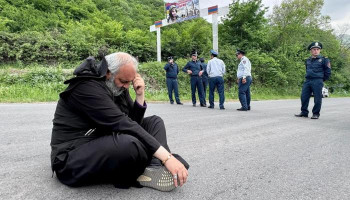Azerbaijan appears to be pursuing a strategy of gradual occupation of Armenian sovereign territory
 It has been one month since our most recent Red Flag Alert concerning Azerbaijan's threats to the sovereign Republic of Armenia. We are now issuing our third such RFA, given Azerbaijan’s escalating rhetoric and demands and its recent attacks on Armenia’s Syunik and Gegharkunik provinces. Previously we have issued numerous RFAs and SOS Alerts for the Republic of Artsakh, which was occupied and depopulated by Azerbaijan on September 19, 2023. Now, as anticipated in our previous publications, the threat of genocide has extended to the sovereign territory of the Republic of Armenia itself. Azerbaijan appears to be pursuing a strategy of gradual occupation of Armenian sovereign territory. It is now seeking control over an additional “eight villages under Armenian occupation” in the Tavush Province and has dismissed Armenia’s claims as mere “political manipulations”. Its goal is the control of the entirety of the Armenian state and the unification of the Azerbaijani mainland with Türkiye, which views Azerbaijan as part of an expansive Turkic nation. By claiming control over strategic points across Armenia, Azerbaijan further appears to be modeling its policy on the Israeli settlements in Palestine. The danger to Armenia has become severe, necessitating immediate and coordinated attention from the international community. Urgent action is imperative to prevent another instance of territorial occupation and genocide akin to what occurred in Artsakh just six months ago. These pressing developments in the Tavush Province appear to show a new development in Azerbaijan's approach to claiming Armenian territory: whereas for the past months Azerbaijan’s priority was claiming “Western Azerbaijan” and the “Zangezur corridor” in Armenia’s southern Syunik province, it is now targeting northern territories, a shift likely influenced by Iran's firm commitment to maintaining the border with Armenia in the south. However, it is essential to recognize that the underlying tensions and risks still persist and must not be ignored. Azerbaijan's stance on Syunik still remains and the underlying risk factors are not eliminated, especially after additional attacks on Tegh village on April 2. Azerbaijan continues to promote international engagement in its concept of “Western Azerbaijan” and actively pushes its agenda behind the scenes, as seen by the “Western Azerbaijan is Historic Turkish Land” conference in the Netherlands on 25 March 2024. Organized by the "Western Azerbaijan Community", the conference centered around the theme of "Western Azerbaijan is Historic Turkish Land." The promotion of the concept of Western Azerbaijan has been actively supported by the Azerbaijani government, with this narrative becoming official state rhetoric, particularly amid “peace negotiations” with Armenia. President Aliyev in one of his speeches insists: “Let us work together on returning to Western Azerbaijan,” referring to the territory of the Republic of Armenia. As of now, Azerbaijan has further intensified its territorial demands. The Armenian government officially confirmed the ongoing Azeri occupation of 31 of its villages. It's crucial to emphasize that the 31 villages in question are on sovereign Armenian territory and are distinct from the enclave-exclave element, which has been a significant factor contributing to the delay in demarcating and delimiting the border between the two countries. An exclave refers to a portion of a territory that lacks geographical continuity with the main body of the country and is entirely enclosed by the territory of another state. An enclave is a part of a foreign state within another country. So, the areas concerned would be exclaves of Azerbaijan or Azerbaijani enclaves within Armenian territory. The four non-exclave villages (highlighted in red), Baghanis Ayrum (Bağanis Ayrım), Nerkin Voskepar (Aşağı Əskipara), Kheyrimly (Xeyrımlı), and Kizil Hajily (Qızılhacılı) in the Tavush region, are demanded by Azerbaijan immediately. The issue of the other exclave villages (highlighted in blue), Barxudarlu (Barxudarlı), Sofulu (Sofulu), Verin Voskepar (Yuxarı Əskipara) located in the Tavush region, and Tigranashen (Karki) in the Ararat Province, as Azerbaijani Deputy Prime Minister Shahin Mustafayev stated, “will be resolved within the framework of the border determination process”. Prime Minister Nikol Pashinyan has said that Armenia could face a war with Azerbaijan if it does not compromise and cede control over four villages in the Armenian Tavush Province, which the Azeri Deputy Prime minister referred to as “unquestionably part of Azerbaijan.” Alarmingly, we have seen military escalations at both Syunik’s Tegh and Gegharkunik’s Kut villages on April 2. The Lemkin Institute remains deeply troubled by the covert genocide unfolding as a result of Azerbaijan's advancing territorial claims, enforced through the continuous military conflict. The situation of the Tavush villages serves as a stark illustration of such territorial claims. However, these assertions and claims are put forth and persist without transparent maps or legal substantiation. Map of Armenian SSR (1931): The exclaves/enclaves in question emerged in Armenia and Azerbaijan in the 1940s during the Soviet era, but the legal basis for their transfer from Armenia to Azerbaijan remains unclear, though decisions made in Moscow and verbal justifications exist. The main rationale was that the villages were transferred due to the majority of their inhabitants being representatives of the neighboring republic (Azerbaijan). However, Armenia contends that the transfers have no legal basis. The territorial exchanges occurred without clear regulation, often at the discretion of local party leaders rather than the republic’s leadership. Questions persist regarding the decision-makers, the timing of enforcement, and the legal legitimacy of the changes. This skepticism is shared by Armenian experts and the country’s leadership, including Prime Minister Nikol Pashinyan, who emphasizes the need for clarification on the legal grounds for the enclave boundaries. For compliance with international law, countries must provide legal documents substantiating their territorial claims to assert demands over specific territories. In the absence of such documentation, the situation remains subject to varying interpretations. The territorial issue is not one-sided. Since the 1990’s, Azerbaijan has been occupying parts of the Armenian territory along the border and an Armenian exclave Artsvashen (Bashkand), located in Qazax District which borders Tavush and Gegharkunik Provinces. Nikol Pashinyan raised the point of returning the formerly Azerbaijani enclaves in exchange for formerly Armenian Artsvashen. He also suggested that the border could be fixed by leaving all the enclaves the way they are at this point, which would solve the problem of Armenia’s transportation to Georgia and Iran. However, there has been no sign from the Azerbaijani side indicating the possibility of returning the Artsvashen enclave to Armenia, nor does Azerbaijan view the status quo as desirable. Importantly, the villages of Tavush straddle the main road between Yerevan and the Georgian border and are in proximity to a main commercial artery that links trade with Georgia in the north and Iran in the south. In the event of any disruption to those highways, finding alternative routes would prove challenging due to Armenia's rugged and mountainous terrain. If Azerbaijan were to seize critical Armenian communication arteries, Armenia risks being cut off from the important Armenian-Georgian Highway and the North-South gas pipeline. The North-South gas pipeline, or North Caucasus-Transcaucasia Gas Pipeline runs from Mozdok (Russia) through Tbilisi (Georgia) to Yerevan (Armenia) and supplies the Republic of Armenia with natural gas. As Armenia does not have any significant energy resources, it is heavily dependent on energy coming from Russia via this pipeline. Any potential move of the Azerbaijani positions closer to the road would pose a substantial threat to the security and stability of vital energy supplies and trade networks of Armenia. In addition to vital communications, the four villages also play a crucial role in Armenia's strategic defensive posture. Armenia currently holds strategic heights and well-developed defensive lines along this part of the border. Tavush stands out as the only region with superior defensive positioning over Azerbaijan compared with other border areas, which can explain Azerbaijan's strong desire to obtain the villages, potentially facilitating the conquest of the entire country. Consequently, Azerbaijani military units could be deployed along five sections of the Yerevan-Tbilisi highway which would render maintenance of the interstate road impossible. This scenario would disrupt crucial communication links between Armenia and Georgia, placing the security of the gas pipeline and export routes in jeopardy. In effect, Armenia would become a veritable enclave encircled by Azerbaijan, compromising its territorial integrity and security. Azerbaijan's reluctance to seek a fair resolution to the territorial dispute, coupled with the ambiguity surrounding the border demarcation and ongoing occupation of sovereign Armenian territory, underscores legitimate concerns for Armenians. It's crucial to note that these villages are inhabited solely by Armenians, and surrendering them to Azerbaijan means that Azerbaijani military units would be positioned in close proximity to Armenian schools, kindergartens, and government institutions. The safety and protection of the inhabitants cannot be guaranteed under such circumstances, especially combined with constant military aggression and threats amid the backdrop of the recent genocide and ethnic expulsion of Armenians from Artsakh. |



















